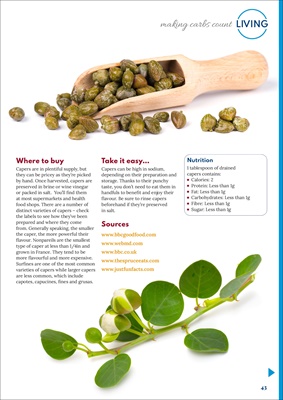
43
LIVING
making carbs count
Where to buy
Capers are in plentiful supply, but
they can be pricey as they're picked
by hand. Once harvested, capers are
preserved in brine or wine vinegar
or packed in salt. You'll find them
at most supermarkets and health
food shops. There are a number of
distinct varieties of capers - check
the labels to see how they've been
prepared and where they come
from. Generally speaking, the smaller
the caper, the more powerful their
flavour. Nonpareils are the smallest
type of caper at less than 1/4in and
grown in France. They tend to be
more flavourful and more expensive.
Surfines are one of the most common
varieties of capers while larger capers
are less common, which include
capotes, capucines, fines and grusas.
Take it easy…
Capers can be high in sodium,
depending on their preparation and
storage. Thanks to their punchy
taste, you don't need to eat them in
handfuls to benefit and enjoy their
flavour. Be sure to rinse capers
beforehand if they're preserved
in salt.
Sources
www.bbcgoodfood.com
www.webmd.com
www.bbc.co.uk
www.thespruceeats.com
www.justfunfacts.com
Nutrition
1 tablespoon of drained
capers contains:
Calories: 2
Protein: Less than 1g
Fat: Less than 1g
Carbohydrates: Less than 1g
Fibre: Less than 1g
Sugar: Less than 1g